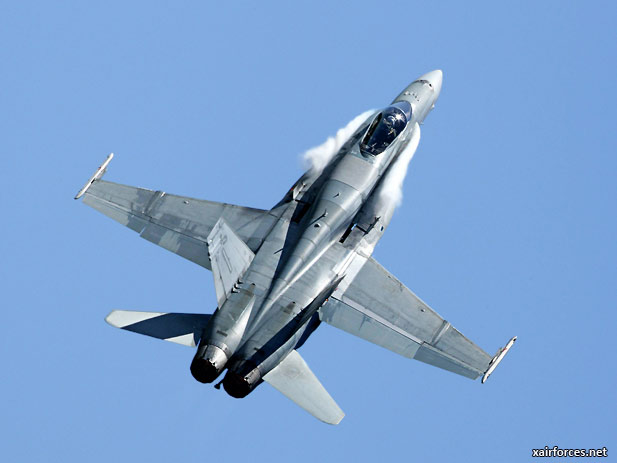
RAAF Classifies Growlers as Support Plane

Is an electronic attack aircraft a combat aircraft? Not according to the Royal Australian Air Force (RAAF), which is classifying its forthcoming squadron of Boeing EA-18G Growlers as a support force distinct from its air combat units.
s an electronic attack aircraft a combat aircraft? Not according to the Royal Australian Air Force (RAAF), which is classifying its forthcoming squadron of Boeing EA-18G Growlers as a support force distinct from its air combat units.
Its move is raising the possibility that the 12 electronic attack aircraft will add to its fast-jet fleet instead of substituting for part of it—although the move may not persuade the government to pay for more fast jets than it has planned.
The defense department, assessing the possibility of buying a second batch of 24 Boeing Super Hornets, is considering the type in all three of its versions, says a spokeswoman: the F/A-18E single-seater, F/A-18F two-seater and the EA-18G two-seat electronic attack configuration. A senior air force officer says -Es are unlikely to be acquired, however.
The U.S. Joint Strike Fighter Program Office, meanwhile, is assuring Australia that it can rely on achieving initial operational capability with the Lockheed Martin F-35 Lightning in 2020. That implies that more Super Hornets will not be needed.
The F-35 software set due for delivery to Australia and other non-U.S. buyers will by 2020 have been in service for five years with the U.S. Marine Corps, project chief Lt. Gen. Christopher Bogdan said at the Australian International Airshow near here late last month. So Australia should not have great concerns.
The country wants to introduce F-35s into service in 2018, says Lockheed Martin F-35 executive Stephen O'Bryan, adding that by then 400 of the aircraft should have been delivered. The Australian authorities must still worry that F-35 deliveries will not occur in time to replace 71 F/A-18A/B Hornets that will run out of life around 2020.
Canberra last decade adopted a plan to order about 100 fighters to replace the Hornets and two squadrons of F-111 strike bombers that were usually kept at an operational strength of 24, but were retired in 2010. Until last year, all 100 new aircraft were supposed to be F-35s; 24 Super Hornets ordered as stop-gap F-111 replacements in 2007 had been earmarked for replacement by the last batch of F-35s.
The situation is now quite uncertain because of decisions last year to keep the 24 Super Hornets, convert 12 of them to Growler configuration and consider ordering another 24 Super Hornets while awaiting F-35s. Amid those changes, however, there has been no hint that the government wants to pay for more than 100 aircraft.
Australia is committed to buying 14 F-35s. The two actually on order will be delivered next year, says O'Bryan. Until last year's decision to look at more Super Hornets, the country intended to buy at least 72 more F-35s under Phases 2A and 2B of the program, Air 6000, between mid-2014 and mid-2016.
Now, “all options, including possible timing changes to Air 6000 Phase 2A/B, are being considered by [the department] as part of its submission to [the] government,” says the spokeswoman. “Any decision to adjust the schedule will be determined by [the] government.”
One factor must be the RAAF's argument that EA-18Gs are support, not combat, aircraft. “While they do attack [electronically], that is a fraction of their role and they cannot do all of the roles of a strike fighter,” says the senior officer. The Growlers will spend much of their time collecting electronic intelligence, not attacking, the officer says. Using them for conventional attacks would be beyond the training of their crews, specialists in the techniques of electronic warfare.
If Growlers are not combat aircraft, then the air force can argue that, despite their induction, it still needs 100 fighters—a mix of Super Hornets and Lightnings, at least at first. The government has made no comment on that possibility, and it is struggling to get its budget back into surplus.
Twelve of the original batch of Super Hornets were built with the wiring needed to turn them into Growlers, but the department's comments reveal that the EA-18Gs, due to achieve initial operational capability in 2018, may be newly built as part of the second batch.
The RAAF remains keen to procure 100 F-35s, since it sees the type as the most advanced available. Service and industry officials say the air force could consolidate on one type by buying a final batch of the stealthy Lockheed Martin fighters as late as the 2030s, when the Super Hornets might be sufficiently worn out to justify retirement—especially if the only Super Hornets that will need replacing are those that began operations in 2010.
Prolonged Growler service need not be an obstacle to early Super Hornet retirement. A small fleet of 12 Growlers might not be so hard to support, the same officials say, since Australia will in any case rely heavily on the U.S. Navy to keep the aircraft going. Regardless of the Super Hornet force, Growler training will be done separately, in the U.S. If 24 aircraft are wired for Growler configuration, then rotation in and out of storage would offer a longer service life.
Australia will not use its Growlers in exactly the same way as the U.S. Navy does, says the senior officer, declining to give details except to note that the RAAF will not fly the same types available to U.S. electronic attack units.
F/A-18Es in any second Super Hornet batch are unlikely because it would be cheaper and more flexible to operate only two-seaters, says the senior officer. If a second crewmember is not needed, the Australian Super Hornets will fly with one seat empty.
Source: By Bradley Perrett - Aviation Week & Space Technology News - 20 March 2013
Photo: The Royal Australian Air Force F/A-18A Hornet (Photo by U.S. Navy)
(20.03.2013)
|